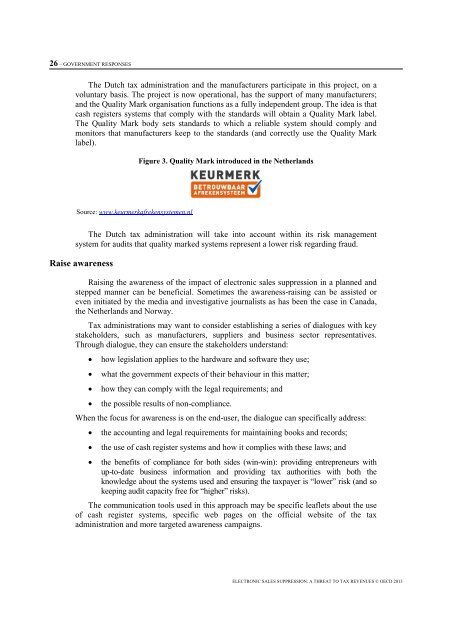ELECTRONIC SALES SUPPRESSION: A THREAT TO TAX REVENUES
ELECTRONIC SALES SUPPRESSION: A THREAT TO TAX REVENUES
ELECTRONIC SALES SUPPRESSION: A THREAT TO TAX REVENUES
Create successful ePaper yourself
Turn your PDF publications into a flip-book with our unique Google optimized e-Paper software.
26 – GOVERNMENT RESPONSES<br />
The Dutch tax administration and the manufacturers participate in this project, on a<br />
voluntary basis. The project is now operational, has the support of many manufacturers;<br />
and the Quality Mark organisation functions as a fully independent group. The idea is that<br />
cash registers systems that comply with the standards will obtain a Quality Mark label.<br />
The Quality Mark body sets standards to which a reliable system should comply and<br />
monitors that manufacturers keep to the standards (and correctly use the Quality Mark<br />
label).<br />
Source: www.keurmerkafrekensystemen.nl<br />
Figure 3. Quality Mark introduced in the Netherlands<br />
The Dutch tax administration will take into account within its risk management<br />
system for audits that quality marked systems represent a lower risk regarding fraud.<br />
Raise awareness<br />
Raising the awareness of the impact of electronic sales suppression in a planned and<br />
stepped manner can be beneficial. Sometimes the awareness-raising can be assisted or<br />
even initiated by the media and investigative journalists as has been the case in Canada,<br />
the Netherlands and Norway.<br />
Tax administrations may want to consider establishing a series of dialogues with key<br />
stakeholders, such as manufacturers, suppliers and business sector representatives.<br />
Through dialogue, they can ensure the stakeholders understand:<br />
• how legislation applies to the hardware and software they use;<br />
• what the government expects of their behaviour in this matter;<br />
• how they can comply with the legal requirements; and<br />
• the possible results of non-compliance.<br />
When the focus for awareness is on the end-user, the dialogue can specifically address:<br />
• the accounting and legal requirements for maintaining books and records;<br />
• the use of cash register systems and how it complies with these laws; and<br />
• the benefits of compliance for both sides (win-win): providing entrepreneurs with<br />
up-to-date business information and providing tax authorities with both the<br />
knowledge about the systems used and ensuring the taxpayer is “lower” risk (and so<br />
keeping audit capacity free for “higher” risks).<br />
The communication tools used in this approach may be specific leaflets about the use<br />
of cash register systems, specific web pages on the official website of the tax<br />
administration and more targeted awareness campaigns.<br />
<strong>ELECTRONIC</strong> <strong>SALES</strong> <strong>SUPPRESSION</strong>: A <strong>THREAT</strong> <strong>TO</strong> <strong>TAX</strong> <strong>REVENUES</strong> © OECD 2013


